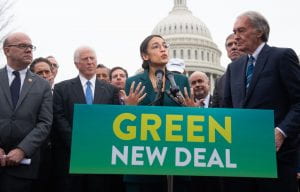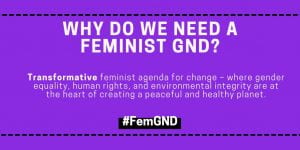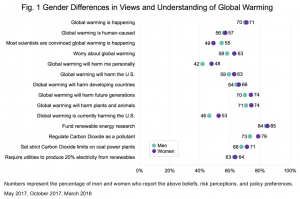In their article “Gender Equality and State Environmentalism,” Norgaard and York’s research assisted in shedding light on gender gaps in environmental politics in different nation-states. Their findings concluded that nation-state’s with higher percentages of females in higher political positions, such as Sweden and Norway, the more likely they are to enact environmental policies and ratify environmental treaties. Along with their research findings, they also discuss factors in ecofeminist/feminist theory that contribute to the link that women in politics may have on environmental treaties. Norgaard and York identify such factors as women being associated with being more compassionate, therefore having intuition for environmentalism, as well as the ecofeminist theory that sexism and environmental degradation are linked, making women in politics more prone to supporting ratification of environmentalist treaties.
One woman in politics that I related to Norgaard and York’s thesis is Alexandria Ocasio-Cortez. Ocasio-Cortez is a Congresswoman in the US House of Representatives, and she has introduced legislation entitled the Green New Deal to combat carbon emissions across the United States, as well as helping boost the economy by creating jobs (Kurtzleben 1). This legislation also includes awareness for poor, disabled, and minority populations that this legislation may impact due to the drastic economic reform (Kurtzleben 1). The reason that AOC and the Green New Deal instantly came to mind is because she is a young female Congresswoman seeking great environmental reform for our nation. The 2018 midterm elections led to more women in winning campaigns for elected office since 1992, and with it came more representation for women in politics. AOC serves as a positive influence for representation for women, and furthers Norgaard and York’s thesis that having women in politics can lead to more environmental reform.
To go along with the Green New Deal, the organization WEDO (Women’s Environment and Development Organization) detailed in an article how they worked with other women’s organizations to advocate for social justice rights within the legislation (WEDO 1). These organizations for women are seeking political involvement with the development of the Green New Deal to encompass the interests of a feminst agenda that involves ideas for social justice for minority populations such as people in the Global South, indigenous women, all women of color, the LGBTQ+ community, and other underrepresented populations (WEDO 1). The organizations sent women from the coalition to present their agenda in order to “…make sure all folks have access to basic resources and distribute them in ways where everyone is taken care of.” (WEDO 1). By having feminist ideals from women’s political organizations connected to the environmentalist policies behind the Green New Deal, this demonstrates that having women in positions of political power allows for environmental reform as stated by Norgaard and York.
According to the Yale Program on Climate Change, statistics have shown that there are gendered differences on the importance of environmental issues, specifically climate change. In the figure above, it is noted that women lead in every category with the exception of one. “A large body of research shows a small—but consistent—gender gap in environmental views and climate change opinions. On average, women are slightly more likely than men to be concerned about the environment and have stronger pro-climate opinions and beliefs (Ballew et. al 1).” These statistics also reference Norgaard and York’s findings to support the idea that women in political power can foster climate reform policies and inspire young women to also take part in environmental policies (Ballew et. al 1), as shown with WEDO’s political participation.
Sources:
Ballew, Matthew, et al. “Gender Differences in Public Understanding of Climate Change.” Yale Program on Climate Change Communication, 20 Nov. 2018, climatecommunication.yale.edu/publications/gender-differences-in-public-understanding-of-climate-change/.
Kurtzleben, Danielle. “Rep. Alexandria Ocasio-Cortez Releases Green New Deal Outline.” NPR, NPR, 7 Feb. 2019, www.npr.org/2019/02/07/691997301/rep-alexandria-ocasio-cortez-releases-green-new-deal-outline.
Norgaard, Kari and Richard York. “Gender Equality and State Environmentalism.” GENDER & SOCIETY, Vol. 19 No. 4, August 2005 506-522. https://pages.uoregon.edu/norgaard/pdf/Gender-Equality-Norgaard-York-2005.pdf
“Women’s Rights and Climate Activists Launch a Feminist Agenda for a Green New Deal.” WEDO, 25 Sept. 2019, wedo.org/feminist-green-new-deal-press-release/.
“Women, Politics and the Environment.” Women Deliver, 10 Mar. 2019, womendeliver.org/2019/women-politics-and-the-environment/.
This source from Women Deliver aided in the additional understanding of how women contribute to the overall benefit of environmental political policy. Women such as Tiza Mafira and Binta Yahaya were discussed in this article to show how women are contributing to environmentalism in nations such as Indonesia and Nigeris to showcase their environmental policy accomplishments.




Hi Madi,
I think you explained the article by Norgaard and York really well. There is definitely a connection between women in politics and environmental treaties. There are a large number of political women who have done something associated with trying to make laws and regulations in the best interest of the environment. When I was searching what different women have done it was very interesting to see. So many women have made so many changes and improvements. Throughout this entire class so far we have been discussing the close connection between women and nature and with every topic that is clear. The way women developed throughout history is still having an impact today. They are continuously making changes and keeping the environment in mind. You also mentioned that Norgaard and York believe women are like this because they tend to be more caring and I agree with this. Women are definitely more caring than men in some cases and this caring aspect that they have definitely influences their concerns about the environment and their passion to make changes for the better. The women you mentioned, Alexandria Osacio- Cortez has done a lot of amazing things. I have actually never heard of her but reading your description of her accomplishments was very interesting to me. She has done so much and definitely want to look more into the work that she has done. I have heard of the Green New Deal and believe it would really help out environment, but I did not know that she was the one who discovered it. The Green New Deal is a very bold plan and I believe that this will bring more attention to the climate crisis and hopefully change some peoples views.
When I was taking in the reading from Norgaard and York, I also immediately thought of Alexandria Ocasio-Ortez. She seems to be one of the most talked about female politicians currently, and has a lot of big ideas for change. She built her entire campaign through a grassroots movement, so you know she was able to reach a lot of people with her passion and ideas. The Green New Deal is one of the bills that she helped write and strongly advocates for. Versions of this deal have been around for awhile, but this is the first one with a woman’s name attached to it. The Green Party previously had worked on a concept they also called the Green New Deal, but as it wasn’t from a major party, it didn’t garner as much attention. A youth activist group called The Sunrise Movement (which includes many women) held a sit-in outside Nancy Pelosi’s office, which helped inspire her to support the movement. AOC is the face, but there is a lot of strong women (as well as men) behind her helping push it as well.
More here:
https://www.nytimes.com/2019/02/21/climate/green-new-deal-questions-answers.html
Hi Madi,
your explanation of Nogaard and York was very easy to read and you can tell that you understood the thesis and main ideas of the paper. It is interesting that you thought of AOC and the Green New Deal because she is very vocal and outspoken but I did not even think of her as an example. That was very smart because it’s an example right in our own country. I think that Nogaard and York make very valid points of women and their connection to environmentalism. That being said that even with women in power unless there is a collective in policy making it can be difficult to achieve successful environmental solutions. Look at . The US ranks #41 for parliamentarians and #11 for the environment; while china ranks #15, but #43 for the environment.
In any case we have seen continuously throughout the semester that women and nature are interconnected. The best way to achieve environmental success is collective policy making and bridging the gap between gender inequality.
Hey there, You’ve done a fantastic job. I’ll certainly digg it
and personally recommend to my friends. I am confident they’ll be benefited from this website.
Also visit my web site: read the article
Hi there to all, how is everything, I think every one is getting more from
this website, and your views are pleasant in favor of new viewers.
Also visit my blog :: learn the facts here now
Greetings from Ohio! I’m bored to tears at work so I decided to
browse your blog on my iphone during lunch break. I love the info you provide here and can’t
wait to take a look when I get home. I’m surprised at
how fast your blog loaded on my phone .. I’m not even using WIFI,
just 3G .. Anyhow, fantastic site!
My web blog :: view publisher site